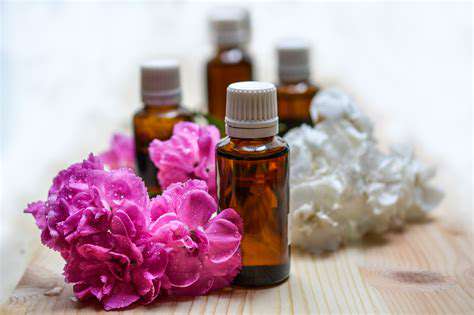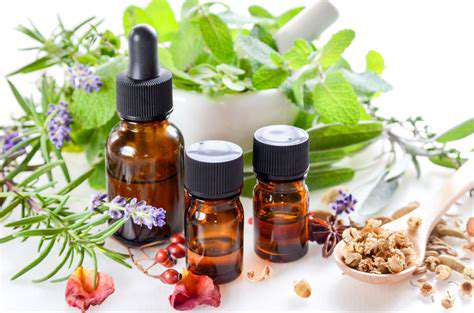Origins and PrinciplesAromatherapy is an ancient healing practice rooted in the wisdom of early civilizations like Egypt, India, and China. These cultures incorporated fragrant plant extracts into their medicinal and spiritual rituals, recognizing their power to influence both body and mind. The essence of aromatherapy lies in its ability to engage our olfactory system, creating a direct pathway to the brain's emotional centers. When we inhale these natural essences, they trigger responses in the limbic system - the brain's control center for memories, emotions, and even some physiological functions.
Contemporary practitioners blend this ancestral knowledge with modern scientific understanding. They employ various application methods - from gentle diffusion to targeted topical use - each offering distinct therapeutic advantages. What makes aromatherapy particularly valuable today is its dual capacity to ease modern stressors while supporting physical wellness, positioning it as a cornerstone of integrative health approaches.
The Chemical Complexity of Essential Oils
Each essential oil represents a sophisticated biochemical cocktail, containing hundreds of active compounds like terpenes, esters, and phenols. These molecular constituents work in concert to produce both the characteristic aromas and healing properties we associate with different plants. Consider lavender's dominant linalool content, which explains its renowned calming effects, or eucalyptus's rich cineole concentration that makes it so effective for respiratory relief.
The therapeutic value of these oils isn't accidental - it's directly tied to their precise chemical makeup, which can fluctuate dramatically based on growing conditions, harvest timing, and extraction techniques. Modern analytical methods allow us to identify these bioactive components with precision, enabling more targeted and effective use in therapeutic settings while ensuring user safety.
How Aromatherapy Interacts With Our Nervous System
The magic begins when aromatic molecules stimulate specialized receptors in our nasal passages. These receptors transmit signals directly to the limbic system, bypassing conscious thought processes. This explains why certain scents can instantly transport us emotionally - perhaps reminding us of childhood memories or suddenly lifting our spirits. Citrus aromas tend to energize, while floral notes like chamomile promote tranquility.
Scientific investigations reveal measurable physiological impacts, including reduced cortisol (the stress hormone) levels and improved sleep patterns. These findings validate what traditional healers knew intuitively - that carefully selected aromas can rebalance our neurochemistry, offering natural support for anxiety, mood disorders, and sleep disturbances without pharmaceutical interventions.
Aromatherapy's Growing Role in Healthcare Settings
Forward-thinking medical facilities increasingly incorporate aromatherapy into patient care protocols. Nurses might diffuse lavender in recovery rooms to ease post-operative anxiety, or apply diluted peppermint oil to help manage headache discomfort. These applications don't replace conventional treatments but rather complement them, creating a more holistic healing environment.
As research accumulates, healthcare professionals are developing standardized protocols for aromatherapy use. This professionalization marks a significant shift from folk remedy to evidence-based adjunct therapy, with quality control measures ensuring both efficacy and safety, especially when used alongside prescription medications.
Innovations Expanding Aromatherapy's Horizons
Cutting-edge research is uncovering exciting new applications for essential oils. Scientists are investigating their potential neuroprotective effects, anti-inflammatory properties, and even antimicrobial capabilities. Advanced delivery systems like nano-encapsulation are enhancing oil absorption and duration of action, opening doors to more precise therapeutic applications.
This scientific validation is fostering greater acceptance within mainstream medicine. We're witnessing the emergence of a new paradigm where plant-based therapies stand alongside pharmaceuticals, offering gentler alternatives for preventive care and chronic condition management. The future promises even more sophisticated applications as we deepen our understanding of these natural compounds.
Key Essential Oils and Their Documented Benefits for Pain and Mood
Evidence-Based Pain Relief From Essential Oils
Traditional pain-relieving claims for certain essential oils now enjoy scientific support. Research highlights lavender's ability to ease tension headaches, peppermint's effectiveness for muscle discomfort, and chamomile's anti-inflammatory properties. These oils appear to work through multiple mechanisms - calming nervous system overactivity, reducing localized inflammation, and possibly influencing our pain perception thresholds.
While promising, researchers emphasize the need for larger, more rigorous studies to establish optimal formulations, dosages, and protocols. Future investigations should explore potential synergies between different oils and their interactions with conventional pain medications.
The Science Behind Scent and Emotion
Mounting evidence explains why certain aromas uplift our spirits. Citrus oils like bergamot and sweet orange appear to stimulate neurotransmitter activity associated with positive mood states. Rosemary's invigorating scent may enhance cognitive performance while reducing mental fatigue. These effects stem from the direct connection between our olfactory system and brain regions governing emotion and memory.
Lavender's Dual-Action Benefits
No oil has been studied more extensively than lavender for its combined physical and emotional benefits. Its analgesic properties help manage various types of discomfort, while its anxiolytic effects promote relaxation and emotional balance. This unique dual action makes lavender particularly valuable for stress-related conditions where physical and psychological symptoms intertwine, such as tension headaches or stress-induced insomnia.
Peppermint's Refreshing Therapeutic Profile
The cooling sensation of peppermint oil comes from its high menthol content, which interacts with temperature-sensitive nerve endings. This mechanism explains its effectiveness for headache relief and muscle soreness. Emerging research suggests peppermint may also enhance mental clarity and focus, though its mood-modulating effects require further investigation compared to its well-documented physical benefits.
Citrus Oils: Nature's Sunshine in a Bottle
The bright, cheerful aromas of citrus oils do more than please the senses - they demonstrate measurable mood-enhancing properties in clinical settings. Lemon, grapefruit, and bergamot oils appear particularly effective for combating low mood and fatigue. Their uplifting effects may stem from multiple mechanisms, including increased oxygen uptake and stimulation of feel-good neurotransmitters like serotonin.
Essential Oil Safety Considerations
While generally safe, essential oils demand respect as potent plant medicines. Always dilute oils properly before skin application, and be mindful of potential interactions with medications. Certain oils are contraindicated in pregnancy or for individuals with specific health conditions. Consulting a qualified aromatherapy practitioner ensures safe, effective use tailored to individual needs. Proper storage preserves oil potency and prevents oxidation that could cause skin irritation.
The Mind-Body Benefits of Aromatherapy

How Aromatherapy Affects Physical Wellbeing
Aromatherapy's physiological impacts are profound and measurable. Certain oils can lower blood pressure and heart rate, while others boost immune response. The connection between scent and physiology operates through multiple pathways, including direct effects on the autonomic nervous system and indirect effects via stress reduction. For instance, bergamot oil has demonstrated significant cortisol-lowering effects in stressed individuals.
Psychological Transformation Through Scent
Our emotional responses to aromas aren't merely subjective - they reflect real changes in brain activity. Neuroimaging studies show distinct patterns when subjects inhale different essential oils. Pleasant aromas activate reward centers while reducing activity in areas associated with negative emotion processing. This explains why aromatherapy can be so effective for managing anxiety and improving emotional resilience.
Cognitive Enhancement Through Aromatics
Certain essential oils demonstrate remarkable effects on mental performance. Rosemary oil, for example, has been shown to enhance memory retention and alertness. These cognitive benefits likely result from increased cerebral blood flow and modulation of acetylcholine activity, a neurotransmitter crucial for learning and memory. Such findings suggest exciting applications for age-related cognitive decline and concentration difficulties.
The Holistic Mind-Body Connection
Aromatherapy exemplifies the inseparable link between physical and mental health. Chronic stress manifests physically through inflammation, immune suppression, and cardiovascular strain. By addressing stress at its neurochemical roots, aromatherapy interrupts this damaging cycle. The most effective protocols often combine oils that target both psychological stressors and their physical manifestations for comprehensive wellness support.
Environmental Influences on Aromatic Effectiveness
The setting in which aromatherapy occurs significantly impacts its benefits. A calm, comfortable environment enhances relaxation responses, while active diffusion in workspaces can improve productivity. Cultural associations with certain scents also influence individual responses, highlighting the importance of personal preference in aromatherapy selection. This environmental dimension reminds us that healing occurs within a context, not in isolation.

Disclaimer: All articles on this site are original, please do not reprint

